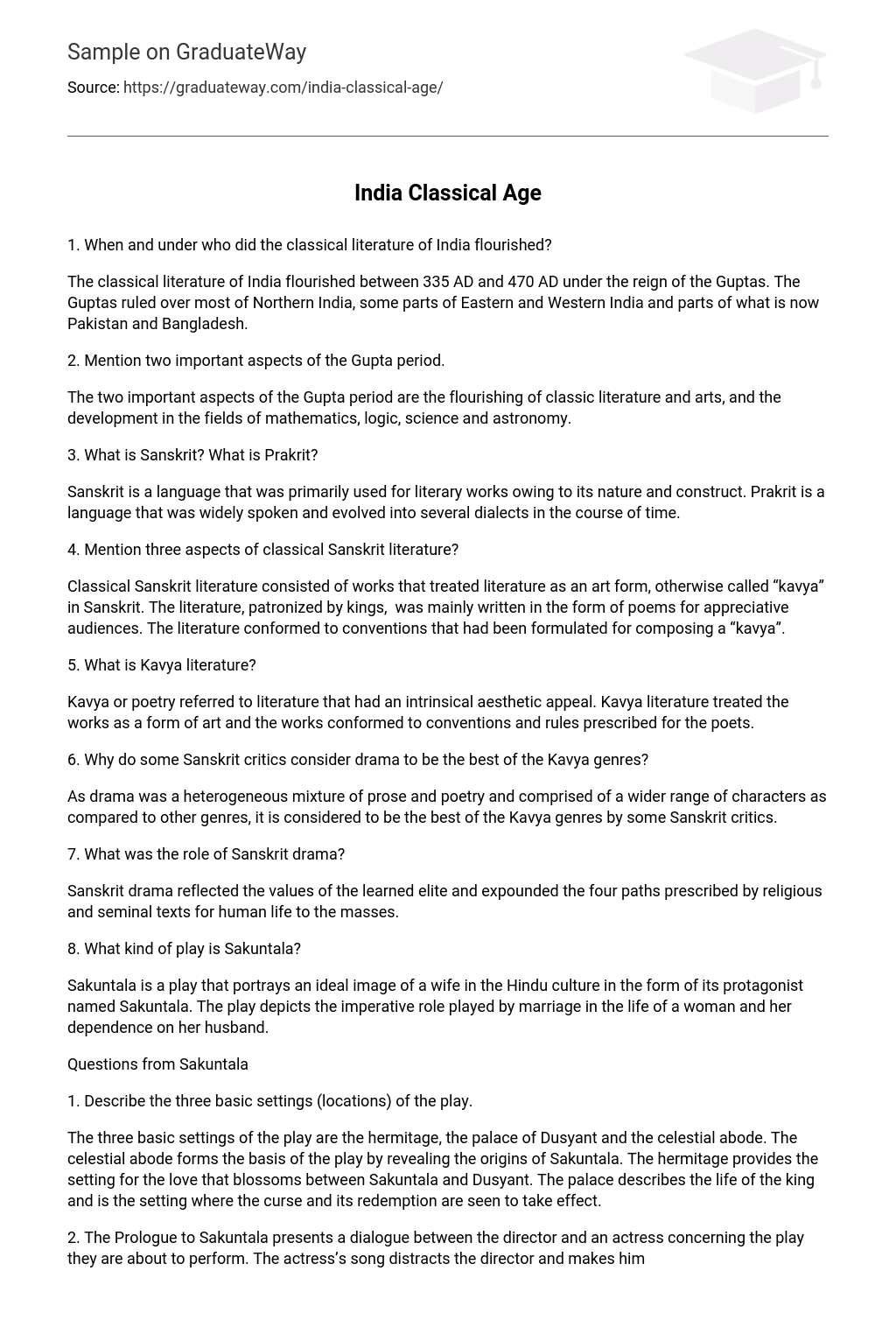1. When and under who did the classical literature of India flourished?
The classical literature of India flourished between 335 AD and 470 AD under the reign of the Guptas. The Guptas ruled over most of Northern India, some parts of Eastern and Western India and parts of what is now Pakistan and Bangladesh.
2. Mention two important aspects of the Gupta period.
The two important aspects of the Gupta period are the flourishing of classic literature and arts, and the development in the fields of mathematics, logic, science and astronomy.
3. What is Sanskrit? What is Prakrit?
Sanskrit is a language that was primarily used for literary works owing to its nature and construct. Prakrit is a language that was widely spoken and evolved into several dialects in the course of time.
4. Mention three aspects of classical Sanskrit literature?
Classical Sanskrit literature consisted of works that treated literature as an art form, otherwise called “kavya” in Sanskrit. The literature, patronized by kings, was mainly written in the form of poems for appreciative audiences. The literature conformed to conventions that had been formulated for composing a “kavya”.
5. What is Kavya literature?
Kavya or poetry referred to literature that had an intrinsical aesthetic appeal. Kavya literature treated the works as a form of art and the works conformed to conventions and rules prescribed for the poets.
6. Why do some Sanskrit critics consider drama to be the best of the Kavya genres?
As drama was a heterogeneous mixture of prose and poetry and comprised of a wider range of characters as compared to other genres, it is considered to be the best of the Kavya genres by some Sanskrit critics.
7. What was the role of Sanskrit drama?
Sanskrit drama reflected the values of the learned elite and expounded the four paths prescribed by religious and seminal texts for human life to the masses.
8. What kind of play is Sakuntala?
Sakuntala is a play that portrays an ideal image of a wife in the Hindu culture in the form of its protagonist named Sakuntala. The play depicts the imperative role played by marriage in the life of a woman and her dependence on her husband.
Questions from Sakuntala
1. Describe the three basic settings (locations) of the play.
The three basic settings of the play are the hermitage, the palace of Dusyant and the celestial abode. The celestial abode forms the basis of the play by revealing the origins of Sakuntala. The hermitage provides the setting for the love that blossoms between Sakuntala and Dusyant. The palace describes the life of the king and is the setting where the curse and its redemption are seen to take effect.
2. The Prologue to Sakuntala presents a dialogue between the director and an actress concerning the play they are about to perform. The actress’s song distracts the director and makes him forget his purpose, but he recovers his memory and recites a verse that leads to directly into the action of the play. How does the prologue foreshadow symbols, situations, and actions?
The prologue foretells of the symbols and situations that will occur in the play. The conversation between the director and the actress, his forgetting about the play and the verse which helps trigger his memory are reminiscent of the meeting between Dusyant and Sakuntala, Dusyant’s loss of memory about their love and the signet ring that helps remember Sakuntala and his love for her, respectively.
3. Explain the symbolism of the bees and trace their presence in the play.
The bees symbolize the intoxication that occurs when one is filled with the desires of life and the desire to satisfy by extracting the juice of happiness from a nourishing source. The bee that follows Sakuntala in the play refers to the king’s love for Sakuntala aesthetically. This is evidenced in the form of Dusyant’s jealousy as the bee flies near the eyes, ears and lips of the maiden Sakuntala.
4. How is the world of the forest/hermitage? Refer to the people and nature.
The world of the forest/hermitage is pristine and peaceful where nature and the people live in harmony. The forest around the hermitage reflects the daily life of the people who devote time to austerities and the upkeep of the forest and the animals residing there. The flora and fauna are undisturbed by the presence of the people.
5. How is erotic love presented? (Think about how love is presented in The Ramayana. This may help you to focus your answer.)
Erotic love is presented by relating to the various states of the plant and animal life seen in the forest/hermitage. The passion of Sakuntala is referred to by the wilting of the lotus blossoms that adorn her and the intertwining of the mango tree and the jasmine creeper that indicate the consummation of the love of Sakuntala and Dusyant are some examples.
6. How is the world of the court?
The court is the place where the king discusses matters of the state with his council of ministers. The place is adorned royally and the king acts in accordance with the advice and suggestions give by his ministers. It also forms a forum where the king can be addressed by others, their grievances heard to and the king deliberates on his actions.
7. Define the word buffoon. What role plays the king’s buffoon?
Buffoon is defined as a clown or a person prone to bumbling. The king’s buffoon, through his conversation, serves to further enhance the passion the king has developed for Sakuntala.
References
Johnson, M. (2007). Adaptation of Sakuntala and the Ring of Recollection. Retrieved 23 March, 2009 from http://www.geocities.com/uu_ringplay/SakuntalaPlayC.doc
Wikipedia.com. (n.d.) Gupta Empire. Retrieved 23 March, 2009 from http://en.wikipedia.org/wiki/Gupta_Empire





